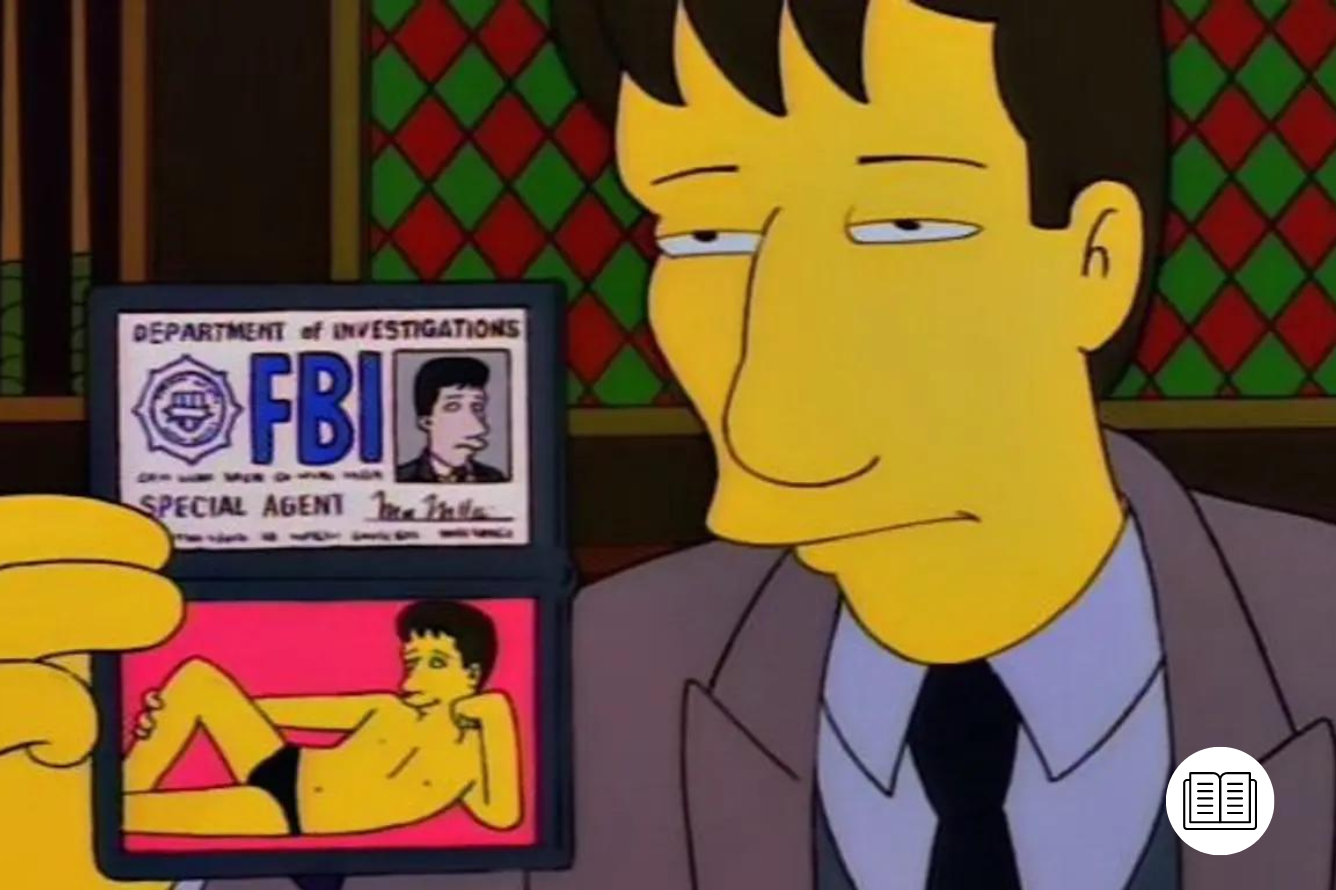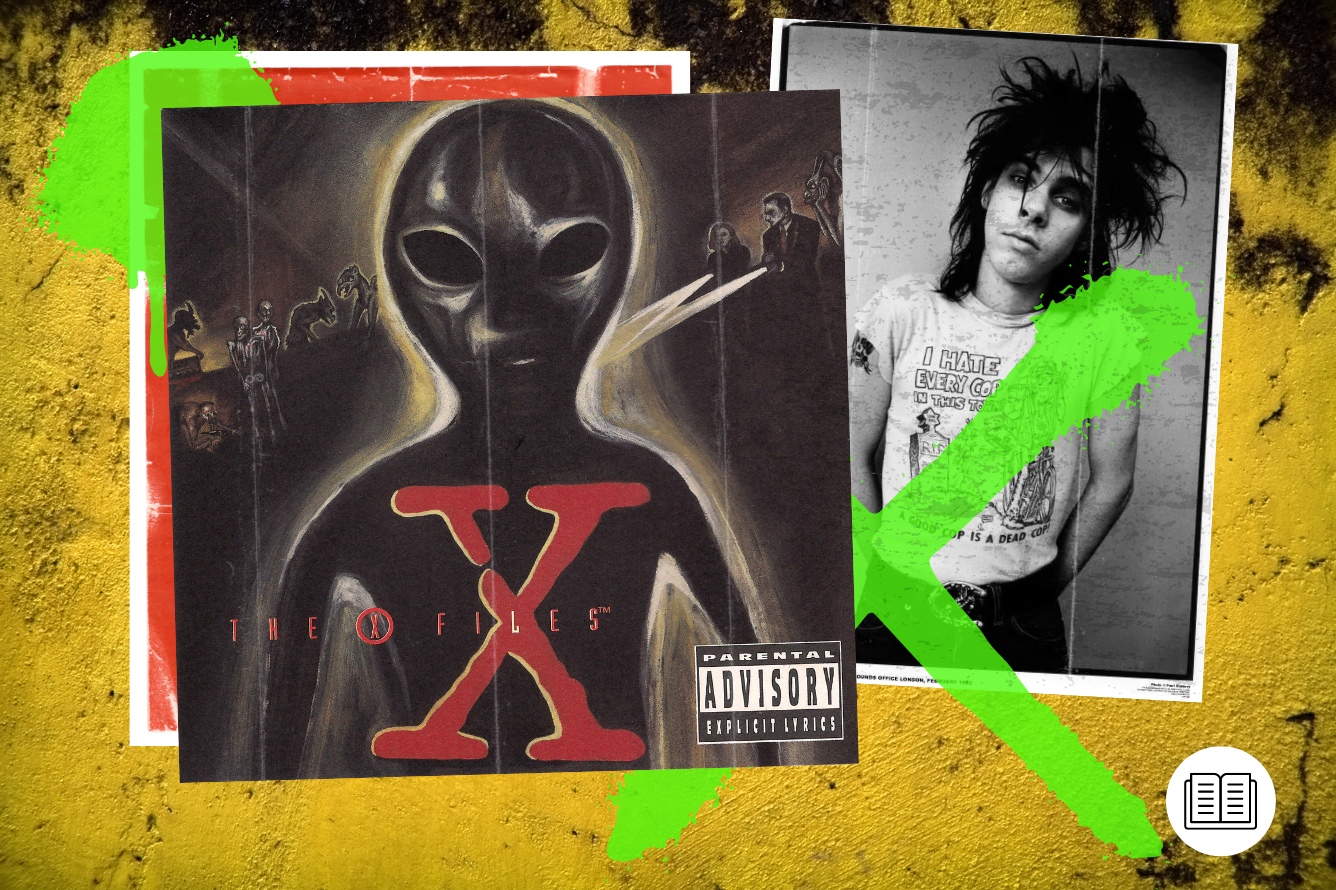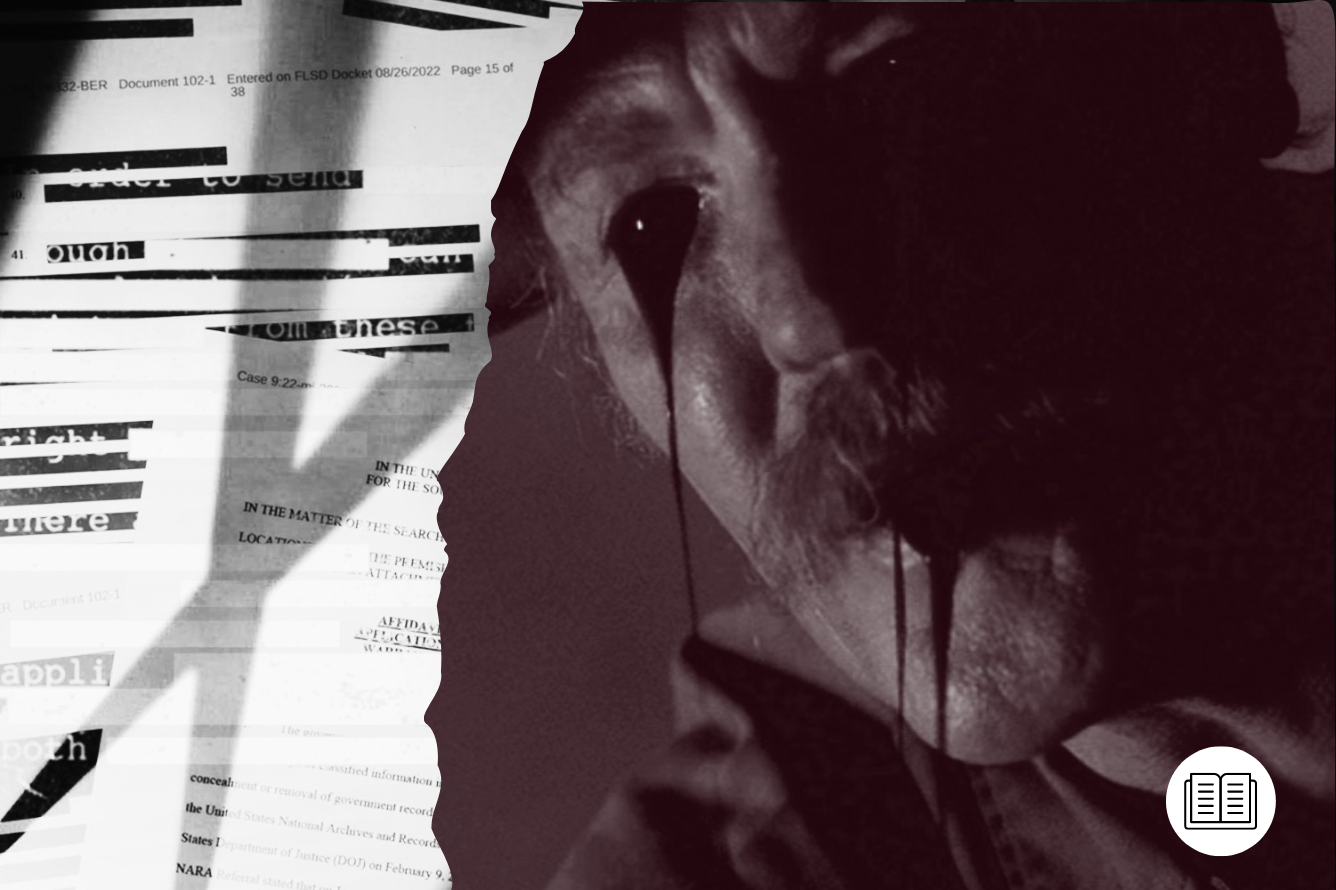Jim Thornton says The X-Files saved his life.
The man now in possession of one of the biggest collections of The X-Files merchandise in the world and founder of The X-Files Preservation Collection, he feels like he owes his very existence to Mulder and Scully. Back in 1993, Thornton was married with two young sons and he was struggling with substance abuse. “I had a very rebellious life,” he admits.
“Let’s put it this way, I lived the rock star life but without the money. It was just really crazy. And I turned around and looked at my kids and said ‘They need better than this.’ I was like ‘I’m just gonna stay home, I’m going to tend to them’ and that’s when The X-Files came on.”
Thornton was always a horror lover and had been a big fan of the 1974 ABC series Kolchak: The Night Stalker where Darren McGavin’s intrepid reporter headed out into the night to investigate mysterious goings-on. It’s no coincidence that Chris Carter cites it as one of his main inspirations for The X-Files. “The pilot came and, for me personally, it felt like Kolchak back when I was younger,” explains Thornton. “It just struck a chord with me and ever since then, that was it, it took off, my lifestyle started changing a little bit. It got better. The show took off with me personally and then the merchandise… The hunt was on.”
The merchandise. Whether you merely had a keyring, a gargantuan collection of space-hogging VHS tapes (to watch with the lights on dans la maison), replica FBI badges, or a t-shirt probably now long-turned to a duster, it was impossible to avoid the explosion of The X-Files collectibles in the mid to late ‘90s. Without the immediacy of streaming, fans were left hungry for more conspiracies on a weekly basis. And what better way to fill that gap than with an extension of Mulder and Scully’s universe? Official merchandise took its time to arrive initially which meant for Thornton, his collection was a slow starter.

“When merchandise came out at first, it was very little. I was with my sister one time and we were at the shopping mall and it was this little booth and they had this binder,” he says, rearranging his The X-Files baseball cap. “And on the cover of it, it said ‘The X-Files Showcase Trading Cards’. I was like ‘what the Heck is that?’ It was just the 72 set trading cards in a binder and I lost my mind! ‘That’s it, I gotta get it.’ And I still have that to this day. It was like ‘wow, I own a piece of the show.’ I mean, lo and behold, it’s just trading cards but there was nothing out there so I got that and then it was like an addiction. And it’s still an addiction.”
The X-Files Game
Trading cards were truly only the beginning of what would become an intimidating range of official tie-ins for 20th Century Fox. Yet few other companion pieces compare in scope to The X-Files Game, released in 1998 for Mac and PC and in 1999 for the PlayStation. This was no alien-busting side-scrolling platformer. The X-Files was a point-and-click full-motion video aka FMV-based adventure shot with the cast and crew of the TV show. This made it a five and half year labor of love and the occasional bout of despair for co-writer, designer, and director Greg Roach.
“From the beginning, our position, and I think this is why Fox ultimately awarded us the work, is that we didn’t want these little tiny pixelated Mulder and Scullys running around on the screen,” he laughs. “That’s just not The X-Files.” Instead, Roach used his development company Hyperbole’s proprietary FMV technology called VirtualCinema to bring The X-Files to life in an interactive way. VirtualCinema allowed the team to shoot action just like an episode but players themselves would decide how the action would play out. Want to show your FBI badge or shoot your gun? Sure. But you better be ready to deal with the consequences. Which was one thing Roach had to face when he initially said no to the project.
“I kind of blew them off,” he chuckles. Hyperbole was busy at the time. The studio was known for its FMV work, he was starting to work on some new IP and, most significantly, he hadn’t watched the series yet. It was only when he did that he realized what a mistake he had made (“This is good shit. I gotta get me some of this!”). After spending nine months constructing a demo and story treatment for Fox, Roach’s studio was chosen. As he expected, a Voodoo plotline was ditched straight off the bat but a few characters were kept and Chris Carter and Frank Spotnitz handed over a story outline.
Given that the leading cast was in the middle of shooting the first movie, Fight the Future (1998), and by this point, the whole show was kind of a big deal, the story meant minimal use of Gillian Anderson and David Duchovny. Instead, the game focuses on new character Agent Craig Willmore, played by Jordan Lee Williams, who spends time liaising with Walter Skinner and The Lone Gunmen in his quest to find Mulder and Scully who go missing in the first scene. The game, while shot during the production of later seasons, fits neatly into the latter part of Season 3’s arc.

Those who have played traditional point-and-click adventures will be somewhat familiar with the interactive elements at work in The X-Files. You’re responsible for a pointer to interact with objects on screen as you investigate locations. Whether checking a computer for clues, using an evidence kit on the suspiciously bloody sand, or reading the frankly intimidating number of files available, every interaction can lead to clues. Unlike other point-and-click games though, each screen here is set between the filmed action of a traditional episode. You can flick between locations using a Newton PDA and wander around each scene but use your brain and the story pulls you along effortlessly. Quite the feat in 1998.
What this meant though was that not only was Roach shooting an episode of The X-Files, he had to film for every eventuality, response, and player emotion. This added up to six hours of footage, the equivalent of a quarter of an X-Files season. “It was pretty overwhelming, candidly. I mean, for me personally, it was a big test because I wrote the thing. Not in isolation obviously, I collaborated with Frank and Richard [Dowdy]. But I wrote it and designed it and now I’m directing it,” he says.
“The first couple of days on the set I was like ‘Fuck…’ I’d done lots of my own stuff before and I’d done well with it. But suddenly it hit me. Oh my God, this is real. You’re in charge of The X-Files. So that alone was, forgive my language, just a mindfuck.”
Even mentally imagine one shot from The X-Files and you realize it has a very distinct look, meaning that every scene in the game had to feel like it belonged in that world for fans to feel truly immersed. Thankfully Roach had a helping hand in that regard when it came to creating a universe where someone like Eugene Tooms would feel truly at home. “The aesthetic bar of The X-Files was set so high for us and I was very fortunate because my director of photography, a guy named John Joffin, was one of the DPs on the show. He was with me every day, making sure that we maintained that famous aesthetic.”
Set in Seattle, the entire episode was shot on live sets without a green screen in lurid sight. Just like the show itself, everything was shot on location, with one main unit to shoot the actors and a second unit whose sole purpose was to shoot the interiors and exteriors for the static investigative elements. It was here Roach freely admits that he learned some difficult and somewhat misty lessons. “We called John ‘The Smoke Nazi’ because, of course, The X-Files hazy atmosphere is a critical aspect of the look,” Roach chuckles. “And so the smoke always had to be right.” The team would get some shots into post-production and find things significantly foggier than planned. “Holy shit, it looks like there’s a fire…”
Understanding The X-Files fans was a big part of the game’s success. From a black and white television jump scare in a motel room not unlike a similar scene in ‘invisible woods monster’ episode ‘Detour’ (S5, Ep4), to a Big Blue mug sitting on a desk, there are enough FBI-flavoured Easter Eggs for any passionate X-Phile. “We knew that X-Files fans were so in love with and so passionate about the characters and the universe and the mythology,” Roach confirms. “And we knew that we had the luxury in the interactive space of indulging that passion, of being able to just completely kind of flood the zone with in-jokes and references.”
The game team worked closely with the show’s crew and production itself changed when a rather key player embraced working on the game. “I have to say, one of the really cool things was working with all of the actors. Gillian in particular, she was just lovely,” remembers Roach. “And she had such a good time on her first round of shooting that we ended up going back and writing more material for her and bringing her back in for another couple of days of additional stuff. Especially at that point in time, they were busy. There was a lot going on with all of them so the fact that she was so generous with her time and so supportive, that just always stuck with me.”

This was no ordinary tie-in project in the 1990s. In 2020 modern video game adaptations like Marvel’s Spider-Man are carefully crafted to cast a protective blanket around the studio’s webbed baby. Back in the ‘90s, it was all to play for with pixelated bargain-basement fodder that only the most rose-tinted of nostalgia goggles can cast in a good light. The X-Files, quite literally, was a game-changer and a commercial success. “I think it had to do with the nature of The X-Files itself,” Roach says “Because of the fact it was a landmark TV show for a variety of reasons; its storytelling, its mood, its atmosphere, its production values, its sophistication. I think that there was a necessity for those values to be carried over to anything else that was done.”
Part of it might also have been because he was terrified of Chris Carter. “I heard stories about Chris that were told to me early on to scare me to not f**k up,” he chuckles. “Chris looking at a truckload full of T-shirts and going ‘That’s not the right green’ and having them destroyed. So early on it put the fear of God in me.
“You’re maintaining the brand purity. But of course, that’s a necessity. It’s way too easy, especially in today’s world for everything to be another knock off, another brand extension to check a box and fill a SKU [stock-keeping unit], to just leech the soul out of things. But then at the same time, I think that some of what The X-Files did, set the bar for certain franchises like Star Wars.”
The X-Files Merchandising Boom
That careful cultivation of merchandise meant that as the show grew in popularity, fans were endlessly hunting for more news and fake ‘I Want To Believe’ posters. Dave Golder was the deputy editor and then editor of the newly launched UK cult sci-fi magazine SFX, and credits The X-Files with cementing the success of the new publication. “The timing was uncannily perfect for us,” he explains. “The X-Files started airing in the States in ‘93 and in the UK in ‘94. SFX launched in ‘95 when the hunger for all things Mulder and Scully related was at its peak.
“The effect on our sales was extraordinary and easy to quantify. The first three issues all had movie covers and sold fine, certainly well enough to please our bosses. Then with issue 4 we put a huge close-up of David Duchovny’s face on the cover, and sales went through the roof.”
It didn’t take Scully’s microscope and a hunt for a scientific explanation to know that the team was onto something. The desire for X-Files content meant that the magazine was suddenly trying anything to meet demand. “By issue 19 the show was so popular, we did something with the magazine that anybody who knows anything about ‘what sells magazines?’ – which is nobody – would have cited as madness,” says Golder. “That issue had an X-Files supplement… enclosed within a matte black, polythene bag with nothing on it other than the magazine’s logo, the words, “The X-Files: The Truth Is In Here” and a barcode. It was and remains the biggest selling issue of SFX ever. On a personal level, it was great to interview Gillian Anderson and give her a Rorschach test that prompted the immortal response, ‘two kissing penises’.”
Golder’s ‘90s memories of X-Files-related collectibles at the time are a little bit like the shop we’ve all been to that smells a lot like incense and sells more ‘coffee’ grinders than you would ever need. “I don’t recall any strange official merchandise, but there was a lot of odd stuff that was clearly riffing off The X-Files,” he explains.
“There was an alien grey baby in a plastic tube full of foul-smelling gloop, some freaky, Fortean-themed tarot cards and a fashion label called Schwa whose logo was a grey alien head. I was always amazed Fox never officially licenced a Stretch Armstrong-style Flukeman toy.”
But maybe your first time putting the X into experience wasn’t seeing inflatable aliens, watching the show, or even playing a game. Perhaps it was picking up a book. The X-Files had a veritable library of official companions that included novelizations of some of the most iconic episodes. Author Ellen Steiber was responsible for seven of the individual books specifically intended for young adult audiences, including the iconic Tooms-starring ‘Squeeze’ (S1, Ep3). The subject matter immediately appealed and when one of her editors at HarperCollins asked if she was interested, she jumped at the chance to be involved.
“I’m always up for a good, eerie story so I was pretty much hooked from the beginning,” she says. “But X-Files did far more than tell scary stories. It explored that very basic question: What is truth? Or: Is there more than what ‘normal’ experience tells us and can we find it? The show reduced this to the pithy answer: ‘The truth is out there’. But beyond that, Chris Carter and his writers had a genius for tapping into the zeitgeist — a fascination with the inexplicable and paranormal, especially with the ideas of UFOs, aliens, and the theory that not only were they real but that they have been here and our government has been covering them up for years. For decades now there have been conspiracy theories about those in power, but X-Files brought them into our living rooms in a weirdly plausible way.”

While the idea of gender-swapped horror tropes – the rational woman scientist versus the more open-minded man – really appealed to Steiber, she was especially intrigued by the horror at work. “Though the show sometimes veered into the ridiculous, it used enough ‘ripped from the headline’ elements to be haunting and frequently disturbing,” she explains. “‘Oubliette’ [S3, Ep8] (which I novelized under the title Empathy) tapped into news stories of kids being abducted from their homes — it aired roughly a month after the Polly Klass kidnapping. I knew it was fiction, but damn if it didn’t make me double-check the locks on the doors the whole time I was working on it.”
And, if you’ve ever wondered how companion authors work their magic, it turns out that there’s no real conspiracy. It involves a lot of physical media. “For every episode, the writers were sent a VHS videotape,” Steiber says. ”I can’t remember now if we also got a script. I do remember taking notes obsessively as I rewound and replayed scenes, trying to get the dialogue right and then describe the settings as closely as possible.” It also turns out that if you’ve ever tried to turn up the brightness on your screen to try and see the final act of an episode, you’re not alone. “The hardest part of writing X-Files adaptations was that the shows often had a sequence, usually the penultimate scene, in which Scully and Mulder stumble around in the dark, pursuing or fleeing from the bad guy,” remembers Steiber.
“There was no way to know what was actually happening. And I knew I couldn’t turn in a paragraph that read, ‘Mulder and Scully stumbled around in the dark.’ I kept praying for better lighting.”
But Steiber’s novelizations were far more than just verbatim recreations of episodes. She relished diving into the occult subject matter to find out the literal devil in the details. “Even if you have a script, you have to fill in a lot — especially characters’ thoughts and background info — in order to turn it into a novel,” she says. “So for me the part that was the most fun was that I would research whatever I could. For ‘Shapes’ [S1, Ep19], I was fortunate to have friends here who were holding Sweat Lodges and other Native American ceremonies. I attended quite a few of these ceremonies, and local Medicine people patiently answered my questions. None of them had encountered a Manitou but they had heard of encounters with Skinwalkers (another kind of shapeshifter), from Native people in California. The legends are not dead.”
Sometimes though, the subject matter crept closer into reality but Steiber didn’t shy away from shining a standard FBI flashlight into the dark side of humanity either. “Empathy concerned two young women kidnapped and held years apart and the unusual empathetic link between them,” she remembers. “I lucked into a phone interview with Clinton Van Zandt who for years had been a supervisor with the FBI’s Behavioral Science or ‘Silence of the Lambs’ Unit. That is, he was a professional profiler. And his descriptions of cases were genuinely chilling. I remember him describing the perpetrators of the worst cases and saying, ‘Some of these people are monsters. There’s no other word for them.’”
Steiber says she felt lucky to work on the series and, while The X-Files phenomena was very much of its time (complete with Barbie and Ken versions of Mulder and Scully), she also sees it as a look to a future that we’re all dangerously aware of. “In retrospect, the show seems almost prescient,” she says. “We’re in a weird time now, particularly in the US, where conspiracy theories abound — QAnon; the theory that Covid-19 was deliberately cooked up in a Chinese lab to destroy America; the idea that dinosaurs never existed and any image of them is evil… Suffice it to say that a lot of carefully wrought science is being dismissed and theories that would have seemed crazy a short time ago are being given credence. And yet many of us have brushed up against the inexplicable, the paranormal. We sense that there is more than reason and science can explain. It’s why we love ghost stories or are intrigued by UFO sightings. And so X-Files, which allows for and embraces all of that, continues to resonate.”
Card-Carrying Fanboy
For Jim Thornton, this resonation has never stopped. His trading card collection turned into buying every piece of merchandise he could get his hands on, sometimes in multiples (“I gotta buy ten. Why ten? I don’t know but I’ve had to buy ten”). The internet, wet behind the ears in the mid-’90s, suddenly grew in importance as he sourced rarer items from eBay and The X-Files Fan Club. Then, something changed.
“It [the collection] went from lots of commercial stuff and then it went to crew gifts,” he explains. “The props came a little bit later. The props and wardrobe. Once the props and wardrobe came, wow, it’s a different level.”

Thornton’s first prop – and the beginning of what he now calls The X-Files Preservation Collection – was a mere battery that was used in one of the cameras on the show. “It wasn’t the greatest prop in the world,” he admits. “It’s nothing too exciting or anything. The cord was kind of messed up and I thought ‘I gotta fix this so it doesn’t break or deteriorate or anything.’ And I thought ‘wait a minute, if this is gone, what else is gone?’” Thornton suddenly started thinking about the trading cards that people would collect with pieces of The X-Files official wardrobe pinned to them. The idea appalled him. “Crap, man, I can’t let that happen. The X-Files turned my life around. I love the show so much. It’s what I live for,” he enthuses. “I’m going to preserve everything I can so it doesn’t get destroyed, lost, or whatever. Because there are millions of fans out there that love it. It’s affected them and I want to bring The X-Files to people that have never even seen the show before.”
So began his ultimate quest for The X-Files props. Head to xfilespreservationcollection.com and you’ll see guns, amputated limbs, street banners, cigarettes… If it was in an X-Files episode, chances are that Jim Thornton has squirreled it away safely in storage units or in his house. Chris Carter himself is well aware of Thornton’s growing collection and has been heavily involved, donating precious items of his own and shipping them from California to New York. Imagine the scene; a shipping container arriving and hissing open with some of John Joffin’s customary smoke. The reality isn’t too far removed. “When we unlocked those locks and opened those doors, I was blown away,” grins Thornton. “It was filled to capacity. And some of the gems that were in there, I just couldn’t believe it. To me, the holy grail is Chris Carter and he sent the mummified alien that was in the casket in the pilot.”
But what now? The X-Files Preservation Collection museum was meant to open this summer in Saratoga Springs in upstate New York but COVID 19 claimed another casualty as Thornton was forced to move the launch to 2021. He’s reflective on the matter. “It was a blessing in disguise. Back in April we were going crazy. We were going to get it done but now we’re going to get it done better and bigger. And we’re working on a lot of surprises that I can’t really say right now.” Thornton wants to give back to a show that he sees as giving him so much. After 25 years of collecting The X-Files merchandise and now props, the preservation of the show for him is now about celebrating the work of invisible hands. “What it really is, is we’re paying tribute to the people who made that prop,” he smiles. “The people who spent all that time on the wardrobe; the people who wore it, and the people behind the scenes. That’s who we are paying tribute to. And, it’s coming. We’re going to blow people’s minds.”
This article was first published on October 21st, 2020, on the original Companion website.
The cost of your membership has allowed us to mentor new writers and allowed us to reflect the diversity of voices within fandom. None of this is possible without you. Thank you. 🙂









